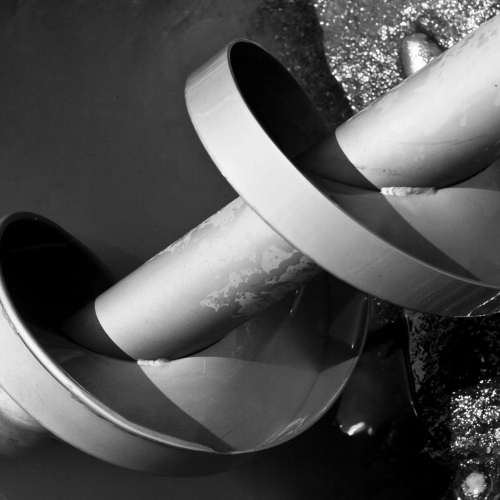
Hydraulics is a branch of science and engineering that deals with the mechanical properties and applications of fluids, particularly liquids. It involves the study of the behaviour and control of fluids, such as water or oil, when subjected to pressure or flow.
Hydraulic systems utilize the principles of fluid mechanics to generate, control, and transmit power. These systems typically consist of pumps, valves, pipes, and actuators. The basic principle is that a fluid, usually an incompressible liquid, is confined within a closed system, and pressure is applied to the fluid at one point. This pressure is transmitted throughout the system, allowing the fluid to perform various tasks, such as generating force, transmitting motion, or transferring energy.
One of the key advantages of hydraulic systems is their ability to transmit force and power over long distances with relatively little loss. This makes them particularly useful in applications where mechanical or electrical systems would be impractical or inefficient. Hydraulic systems are commonly found in various industries, including construction, manufacturing, aerospace, automotive, and agriculture. They are used in a wide range of applications, such as heavy machinery, lifting and moving objects, braking systems, steering mechanisms, and power transmission.
Overall, hydraulics plays a vital role in many sectors of engineering and technology, enabling the efficient and precise control of power and motion through the use of fluids.
Who Invented Hydraulics?
The principles of hydraulics have been understood and utilized for thousands of years, with evidence of hydraulic systems dating back to ancient civilizations such as the Egyptians and Mesopotamians. However, the modern development and understanding of hydraulics can be attributed to several notable individuals throughout history.
One of the earliest pioneers in the field of hydraulics was the ancient Greek mathematician and engineer, Archimedes (circa 287-212 BC). He is credited with discovering the principles of buoyancy and developing various hydraulic devices, including the Archimedes' screw, which is still used today for pumping water and other fluids.

In the 17th century, Blaise Pascal, a French mathematician and physicist, made significant contributions to the field of hydraulics. Pascal's Law, formulated by Blaise Pascal in 1653, states that when pressure is applied to a fluid in a confined space, the pressure change is transmitted equally in all directions. This principle is fundamental to hydraulic systems and is often referred to as Pascal's Principle.
Another prominent figure in the history of hydraulics is Daniel Bernoulli, an 18th-century Swiss mathematician and physicist. Bernoulli's principle, developed by Daniel Bernoulli in 1738, relates the pressure of a fluid to its velocity. It states that as the velocity of a fluid increases, its pressure decreases and vice versa. Bernoulli's principle is crucial in understanding the behavior of fluid flow in hydraulic systems.
Throughout the centuries, numerous engineers, inventors, and scientists have contributed to the advancement of hydraulics, refining its principles and applications. This includes figures such as Joseph Bramah, Henry Maudslay, and Sir William Armstrong, who made important contributions to hydraulic technology during the Industrial Revolution.
It is important to note that hydraulics, as a field of study and application, has evolved over time with the contributions of many individuals. Therefore, it is not attributed to a single inventor but rather to the collective efforts of numerous scientists and engineers throughout history.
How Do Hydraulics Systems Work?
Hydraulic systems work based on the principle that a fluid, typically an incompressible liquid like oil, is used to transmit and control power. The basic components of a hydraulic system include a pump, fluid reservoir, valves, pipes or tubing, and actuators.
Here is a general overview of how hydraulic systems work:
Pump: The system begins with a hydraulic pump that is powered by an external energy source, such as an electric motor or an internal combustion engine. The pump draws in fluid from the reservoir and generates flow and pressure.
Fluid Reservoir: The fluid reservoir stores the hydraulic fluid, which is usually oil. It provides a source of fluid for the system and allows for the dissipation of heat generated during operation.
Valves: Valves play a crucial role in controlling the flow and pressure of the hydraulic fluid. Different types of valves, such as control valves, check valves, and relief valves, are used to direct and regulate fluid flow as needed for specific tasks.
Pipes or Tubing: The hydraulic fluid is conveyed through a network of pipes or tubing, which connects the various components of the hydraulic system. These pipes or tubing need to be strong and capable of withstanding the high pressure of the hydraulic fluid.
Actuators: Actuators are devices that convert hydraulic pressure into mechanical force or motion. The two most common types of actuators used in hydraulic systems are hydraulic cylinders and hydraulic motors.
Hydraulic cylinders: These devices consist of a cylindrical barrel, a piston, and a rod. When hydraulic pressure is applied to one side of the piston, it moves in one direction, exerting force or creating linear motion. Hydraulic cylinders are used for applications such as lifting heavy loads, pushing or pulling objects, and controlling machinery.
Hydraulic motors: Hydraulic motors convert hydraulic pressure into rotary motion. They can drive various types of machinery, such as conveyor belts, winches, and rotating equipment.
Control System: The control system of a hydraulic system manages the operation of valves, pumps, and actuators. It allows for precise control of fluid flow, pressure, and the direction of motion. Control can be manual or automated, depending on the specific application.
In operation, the pump pressurizes the hydraulic fluid, which is then directed through the valves and pipes to the desired actuators. The actuators convert the hydraulic pressure into mechanical force or motion, performing the intended tasks. By controlling the flow and pressure of the hydraulic fluid, hydraulic systems can provide precise and efficient power transmission and control for a wide range of applications.
In Conclusion
Hydraulics is a branch of science and engineering that focuses on the behavior and applications of fluids, particularly liquids, when subjected to pressure or flow. It involves the study of how fluids transmit and control power. By utilizing the principles of fluid mechanics, hydraulics allows for the efficient generation, control, and transmission of forces and motions. Hydraulic systems find extensive use in various industries and applications, offering advantages such as high force capabilities, precise control, flexibility in design, and suitability for demanding environments. With its historical roots and ongoing advancements, hydraulics continues to be a crucial technology for powering and controlling machinery and equipment across different sectors.
To speak to our technical team about your hydraulic solutions please call 0114 276 4460, email info@www.hydraulic-components.net or visit www.www.hydraulic-components.net





 No Minimum Order
No Minimum Order














